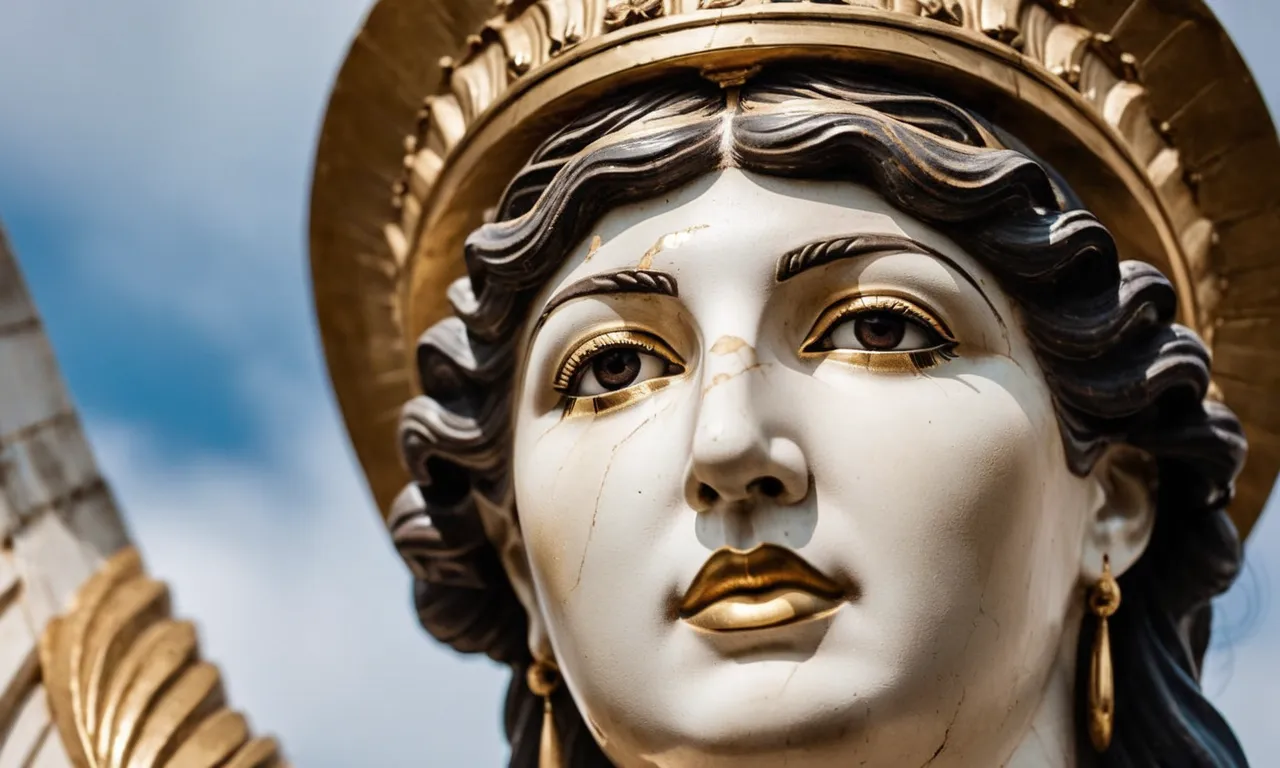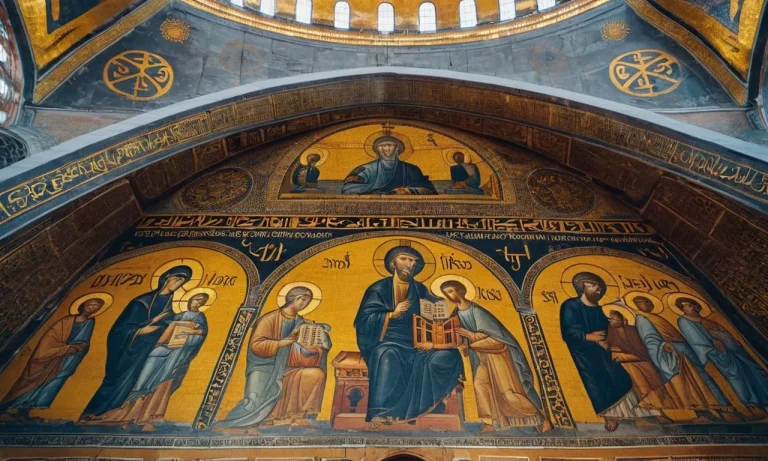Who Is The God Of Wisdom?
Wisdom is a virtue that is valued across cultures and religions. For centuries, humanity has pondered the origins of wisdom and sought guidance from divine sources of knowledge. This quest has led to the emergence of gods and goddesses of wisdom in belief systems around the world.
If you’re short on time, here’s a quick answer to your question: The most well-known god of wisdom is Athena from Greek mythology. However, wisdom gods and goddesses can also be found in Norse, Egyptian, Hindu, Buddhist, and other mythologies.
In this in-depth article, we will explore some of the major gods and goddesses of wisdom from various faiths and regions. We will look at their origins, their attributes, and their significance as sources of divine knowledge for humanity.
Athena – Goddess of Wisdom in Greek Mythology
Origins and Significance
Athena was one of the most important goddesses in Greek mythology. She was the goddess of wisdom, courage, inspiration, civilization, law and justice, strategic warfare, mathematics, strength, strategy, the arts, and skill. Athena was known for her intelligence, reason, and purity.
She was regarded as the patroness of Athens, which was named after her. She was the daughter of Zeus and Metis, though she had no mother. She sprang fully grown and armored from Zeus’s head after he swallowed her pregnant mother. This symbolized her rise as a goddess of intellect and reason.
Athena was a revered and respected goddess. She was one of three virgin goddesses along with Hestia and Artemis. Athena was known for her cool temperament and strategic mind. The Greeks built the Parthenon on the Acropolis of Athens in her honor.
She was associated with the owl, which symbolized wisdom. The olive tree was also sacred to her as she brought it to Athens. Athenians built statues and temples to venerate Athena in Athens and other city-states.
Major festivals such as the Panathenaia celebrated Athena and her gifts of wisdom and knowledge to mankind.
Attributes and Symbols
Athena was often depicted as a tall, dignified, and imposing goddess, fully armored in helmet, shield, and spear. Her symbols included the owl, olive tree, and shield. Athena was associated with the aegis, a protective shield with the terrifying face of a Gorgon upon it.
She was often accompanied by Nike, the winged goddess of victory.
As the patroness of warriors, Athena was shown wearing full armor. However, she usually wore the aegis over the standard Greek chiton robe rather than armor to indicate her status as a goddess. She was portrayed as a young woman with intelligence and resolve in her face.
Statues and friezes show Athena with serene beauty and a steady gaze. The goddess was shown with strong, athletic limbs befitting her association with strength and warfare.
Temples and Worship
The Parthenon was the most famous temple dedicated to Athena. It once housed an enormous gold and ivory statue of Athena crafted by Phidias. This colossal statue was one of the Seven Wonders of the Ancient World. The Erechtheion temple on the Acropolis was also dedicated to Athena and Poseidon.
Other major temples to Athena include the Temple of Athena Nike and the Temple of Athena Alea in Tegea. Worshippers made offerings and sacrifices to Athena at her many temples and shrines. As patroness of Athens, she was honored in festivals such as the Panathenaia.
This grand festival featured a procession and competition to honor the goddess. Olive oil and sacrifices were offered to Athena. The Panathenaic Games were also held in her honor.
Odin – Norse God Closely Linked with Wisdom
Odin’s Quest for Wisdom
Odin, the chief god in Norse mythology, was constantly seeking more wisdom and knowledge. He went to great lengths to obtain this wisdom, including sacrificing one of his eyes at the well of Mímir in order to drink from the well and gain its knowledge.
Odin was willing to suffer pain and make sacrifices in order to gain insights and understand the deeper mysteries of life. His quest exemplifies how wisdom requires effort, discipline and an openness to new perspectives.
According to Norse tales, Odin consulted prophetesses, traveled widely meeting with the dead and minerals, and read ancient runes. He gained knowledge from the giant Mímir and hung himself from the world tree Yggdrasil for nine days and nights in order to receive the wisdom of the runes.
Odin’s relentless curiosity and willingness to explore beyond the familiar make him a god closely linked with the pursuit of wisdom and learning.
Poetic and Magical Wisdom
Odin was associated with poetic inspiration and magical wisdom. As a god of poetry, he inspired poets with creative ideas and eloquent words. He was said to have acquired the “mead of poetry” and brought it back to share with gods and people. Odin also had a strong connection to magic and runes.
He discovered the powerful runic alphabet, which allowed him to alter reality through inscription in wood or stone. His wisdom encompassed both mystical, intuitive knowledge and practical skills like language and writing.
As a shaman-like figure, Odin enacted ecstatic practices to attain altered states and access hidden knowledge. His self-sacrifice while hanging from Yggdrasil exemplifies this shamanic character. He also gained wisdom from his travels in the spirit world conversing with the dead.
Odin represents a type of sage or wizard – someone who seeks understanding of cosmic mysteries and the secrets underlying the visible world. His magic and runes are key components of his hard-won wisdom.
Odin’s Advice and Guidance
In Norse myths, Odin often appears in disguise as a mysterious old man. In this form, he gives advice and guidance to humans and gods. For instance, Odin assisted the hero Sigurd by advising him to dig trenches to capture the magical otter’s gold.
He also lent support to the gods in their conflicts, especially his son Thor. His wisdom put him in a position to counsel and mentor others. Odin shared insights from his deep knowledge and experiences even while concealing his true identity.
Odin’s wisdom was characterized by foresight and seeing beyond surface appearances. As an all-knowing god, he had the ability to see future events and destinies. He traded an eye for wisdom that revealed deeper truths beneath the physical world.
Odin’s counsel took on prophetic aspects and helped others face challenges to come. His sage advice stemmed from his unparalleled understanding of cosmic secrets hidden from ordinary view.
Thoth – Egyptian God of Knowledge and Wisdom
Role as Record Keeper
Thoth was considered the god who maintained the library of scrolls where all the knowledge of the world was recorded. He was thought to oversee scribes, scholars, and priests who studied and interpreted the hieroglyphs found on the scrolls.
Thoth was believed to keep a record of the passing of time and important events, acting as a divine record keeper. He was sometimes depicted holding a tablet and reed pen to represent his role in writing and maintaining records.
Worshipers would pray to Thoth for knowledge and insight before beginning important projects or journeys.
Association with Writing and Science
According to Egyptian mythology, Thoth invented hieroglyphic writing and developed the principles of science, medicine, mathematics, and engineering. He was believed to be the author of the spells in the Book of the Dead and other important magical and scientific texts.
Many ancient Egyptian inventions and advances in knowledge were credited to Thoth, including the 365-day calendar, geometry, astronomy, and writing materials like papyrus. Thoth was so closely linked to writing and science that one of his Egyptian names was “Twice Great” meaning he was the greatest of scientists.
Thoth was also thought to be a great magician who knew the secrets of the earth, stars and afterlife. His association with magic linked him to the moon god Khonsu, and the two were sometimes referred to as brothers.
As a lunar deity, Thoth gained additional associations with time, cycles, mathematics and arbitration.
Temples and Worship
Several important temples were dedicated to Thoth across Egypt, notably in the cities of Hermopolis and Khmun. These temple complexes drew many worshipers who came to present offerings and seek answers, insights and mystical knowledge from the god of wisdom.
The main temple in Hermopolis was one of the largest in Egypt. One researcher notes that “when the rulers of the Old Kingdom (c. 2613-2181 BCE) expanded their power, Thoth grew in importance and later, worship of him spread throughout Egypt.”
Thoth’s symbols included the ibis and the baboon, representing his roles as scribe and messenger of the gods. The crescent moon was another common symbol for Thoth, linking him to the passage of time. Egyptians would often wear amulets and jewelry featuring Thoth’s animal symbols or hieroglyphic inscription to invoke his protection and wisdom.
Saraswati – Hindu Goddess of Knowledge
Significance and Attributes
Saraswati is the Hindu goddess of knowledge, music, art, wisdom, and learning. She is the divine consort of Brahma, the god of creation. Saraswati symbolizes the free flow of wisdom and consciousness. She is considered the mother of the Vedas, the ancient scriptures of Hinduism.
Saraswati is often depicted as an extraordinarily beautiful woman dressed in pure white, sitting on a white lotus flower. She holds a veena, a stringed musical instrument, representing her association with music, arts, and culture.
Her four hands represent the four aspects of human personality – mind, intellect, alertness, and ego.
Some of Saraswati’s most prominent attributes according to the Hindu scriptures are:
- She is the goddess of speech and rational thinking
- She bestows the greatest wealth – knowledge and wisdom
- She dispels ignorance and confusion
- She enhances the culture, arts and skills of human civilization
Saraswati is worshipped by students, teachers, scholars and anyone seeking knowledge, wisdom and illumination. Temples and educational institutions are often dedicated to her. Her blessings are invoked when beginning study of both spiritual and secular subjects.
The Hindu holy day Vasant Panchami is dedicated to her.
Iconography and Symbols
In Hindu iconography, Goddess Saraswati is depicted seated on a white lotus, dressed in white (the color symbolizing knowledge and truth). She rides on a white swan (representing wisdom) or sometimes on a peacock (representing colorful splendor).
She is generally shown to have four arms, which signify her omnipresence and omnipotence. The four hands hold symbolic items like sacred scriptures, a mala (rosary) symbolizing inner reflection, a pot of sacred water representing creative and purificatory powers, and a musical instrument called the veena representing her association with music and performing arts.
The items she holds vary, with some traditions depicting her holding a book (symbol of knowledge), a bow and arrow (focus and strength), a set of prayer beads (inner reflection and spirituality), or a musical instrument like the veena (learning and arts).
Other important symbols representing Saraswati include the white lotus (symbolizing truth, wisdom and spiritual enlightenment) and swans (representing wisdom and discernment). Many Hindu deities are shown seated on lotus thrones. The swan and peacock are also her vahanas (vehicles).
Temples and Festivals
Some of the most prominent Saraswati temples in India are located in Kashmir, Himachal Pradesh and Uttarakhand states. The famous Shringeri Sharada Peetham Temple in Karnataka founded by Adi Shankaracharya is also dedicated to Saraswati.
There is also a Saraswati temple in Koothanur in Tamil Nadu which dates back more than 2,000 years.
Every year, one of the most important Hindu festivals named Vasant Panchami is celebrated to honor Goddess Saraswati. It is celebrated on the 5th day of the bright half of the Hindu lunisolar calendar month of Magha, which typically falls in late January or February.
People dress in yellow attire, share sweets, pray to the goddess and pay homage to books, musical instruments, art supplies and other educational tools.
Many educational institutions arrange special prayers in the morning to seek blessings of the knowledge goddess. The goddess is offered fruits, flowers, incense sticks and lamps during ceremonial rituals.
Charitable events are also organized during the festival to distribute books, clothes, stationary items and computers to needy students.
Manjushri – Buddhist Bodhisattva of Wisdom
Origins and Significance
Manjushri is one of the most significant bodhisattvas in Mahayana Buddhism, embodying the wisdom that leads to enlightenment. His name means “Gentle Glory” in Sanskrit. Legends say he was born from a beam of blue light that came from the Buddha’s forehead, symbolic of transcendent wisdom.
As the bodhisattva of wisdom, Manjushri helps living beings cultivate insight into the true nature of reality. He is said to liberate beings from ignorance and delusion through his teaching. Devotees believe relying on Manjushri develops intelligence and wisdom, which are essential in understanding Buddhist philosophy on the path towards enlightenment.
Depiction in Buddhist Art and Scripture
In Buddhist iconography, Manjushri is often depicted as a youthful prince seated on a lotus flower and holding a flaming sword in his right hand. The sword is used to cut through ignorance and dualistic thinking.
In his left hand, he holds the Prajnaparamita (Perfection of Wisdom) sutra, representing his embodiment of perfect wisdom.
Scenes of Manjushri debating with scholars and converting non-believers reflect his role in spreading Buddhist doctrine. He frequently appears in Mahayana sutras, imparting wisdom to bodhisattvas, gods, and men.
The Manjushri Namasangiti describes him as the teacher of seven Buddhas, highlighting his eternality and significance.
Worship and Celebrations
Manjushri is venerated across Mahayana Buddhism, especially in Tibet, China, Korea, and Japan. Many monasteries have a shrine dedicated to him. He is the central figure of the annual Manjushri procession at Wutaishan in China, where over 10,000 monks gather to pay homage.
The Gangwa Manjushri Festival held in Tibet sees elaborate preparations for the bodhisattva’s ritual bathing with scented water, ceremonial dressing, and prayers. Devotees engage in religious contemplation to emulate his qualities.
Manjushri’s birthday which falls on the fourth lunar month is also celebrated widely by Mahayana Buddhists who chant his name, make offerings, and study scriptures related to wisdom.
As a spiritual guide towards enlightenment, Manjushri remains an immensely popular bodhisattva figure representing wisdom among Mahayana Buddhists. His penetrating insights help us look past delusions to grasp ultimate reality.
Conclusion
Throughout history and across civilizations, humanity has venerated gods and goddesses that represent the virtue of wisdom. These deities have provided divine knowledge and guidance to their followers, and helped shape science, philosophy, and culture.
While their names and attributes vary, wisdom gods generally share certain characteristics – they value learning, truth, ethics and counsel. By exploring their origins and mythology, we gain insight into how different societies conceptualized the meaning of wisdom.
The wisdom gods profiled here are just a sampling of the many divine figures associated with knowledge across world mythologies. Their tales continue to inspire seekers of truth in the modern age, reminding us of the eternal human quest for meaning and understanding.








